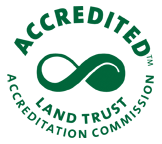As of January 1, 2024, the Rensselaer Land Trust has merged with the Rensselaer Plateau Alliance. For all questions regarding donations, events, land, or other matters, please visit www.rensselaerplateau.org or call 518-712-9211. For questions about the merger, use extension 101 to speak with Jim Bonesteel. You can expect a new name and logo for our merged organization by Spring / Summer 2024 and a new website by the end of the year!
Explore
Explore
We have all heard the classic stories of alien invasions coming to Earth. But did you know that the invasion is happening right now? It’s not an invasion of flying saucers, but rather small plants and creatures that may seem to be plain ordinary members of an ecosystem. These deceptive beasts are none other than: Invasive Species.
Common Invasive Species in New York
So, what’s the scoop? What are they and why are they bad?
An invasive species is defined as a species that is not native to an environment and causes harm to either the environment, the economy, or humans. Invasive species are different from “exotic” species, which are species that come from a different region, but do not cause harm. Invasive species can destroy crops, kill native forest trees, spread disease among native plants and animals, and dominate ecosystems by outcompeting native species. New York is vulnerable to invasive species invasion because it is a big hub for trade.
Invasive species can be plants, bacteria, insects, or other animals - anything that does not come from the ecosystem it is residing in. Some species were brought by mistake by mistake, often hitching a ride on cargo or being dumped in ballast waters from ships, while others are from ornamental plants that grew out of control. Read up about some of the common invasive species that can be found in New York:
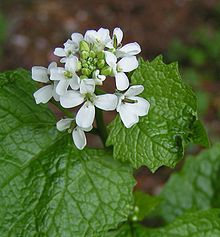 Garlic Mustard: Alliaria petiolata
Garlic Mustard: Alliaria petiolata
Identification: First year growth is small hoof-shaped leaves with rounded edges; second year is flowering with flower spikes; and alternate leaves on stems varying from rounded to pointed with teeth.
Where it’s found: Will grow in many landscapes and ecosystems; common on roadsides and along paths.
What it does: Produces chemicals to prevent other species growth and changes structure of forest floor plants.
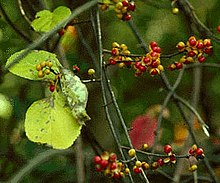 Oriental Bittersweet: Celastrus orbiculatus
Oriental Bittersweet: Celastrus orbiculatus
Identification: Thick vine that grows around and girdles trees; young light green tendrils; alternating leaves ranging in shape from tear drop to large rounded; and red berries with yellow husks visible in winter.
Where it’s found: Will grow in many landscapes. Found on edge territory; will climb trees, fences, and other structures.
What it does: Crowds out native species; shades out trees; and girdles plants that it grows over.
 Japanese Barberry: Berberis thunbergia
Japanese Barberry: Berberis thunbergia
Identification: Long oval leaves clustered on stems; many thorns; inner wood can be bright yellow; bush coloration green or dark red; small red bean shaped berries; and growth can be small bushes or long branches.
Where it’s found: Will grow in disturbed sites and in forests as random patches; popular ornamental.
What it does: Crowds out native species; changes soil ph and temperature; and harbors tick nests.

Purple Loosestrife: Lythrum salicaria
Identification: Tall growth with opposite and whorled leaves with perimeter vein; tall purple flower spike; and square stem.
Where it’s found: Found along roadways, water, and stream banks.
What it does: Produces dense growth making waterway access difficult; outcompetes native plants with dense roots that alter hydrology.
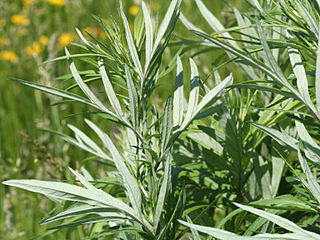 Mugwort: Artemisia vulgaris
Mugwort: Artemisia vulgaris
Identification: Alternating many pointed lobed leaves, vary in shape but all multi-frond like; smooth green stem with small leafy protrusions.
Where it’s found: Popular ornamental for medicinal properties; found in edge habitats, roadways, along water, and waste areas.
What it does: Crowds out native species; contaminates nursery stock through rhizomes; and disrupts natural succession in ecosystems.
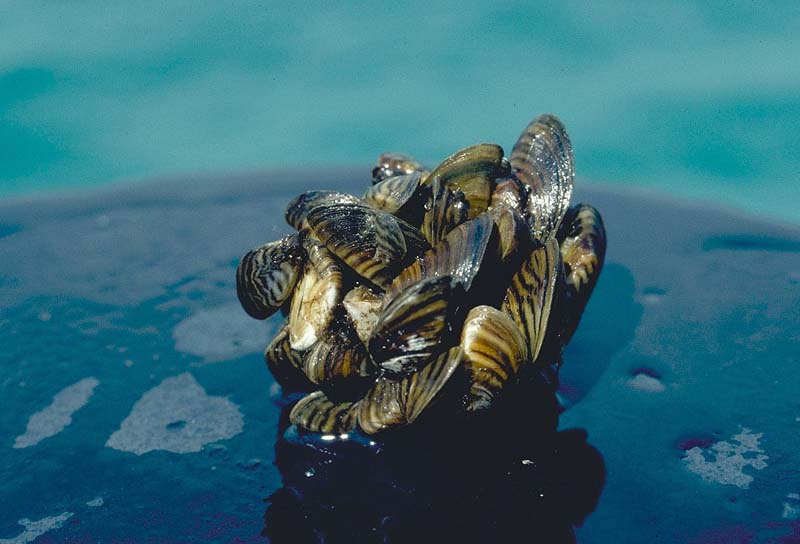 Zebra Mussels: Dreissena polymorpha
Zebra Mussels: Dreissena polymorpha
Identification: Small mussel with brown and tan zigzag stripes and jagged edges; often found in clusters.
Where it’s found: Found in rivers and lakes; dropped out of ballast waters and can secure to boat hulls.
What it does: Crowds out native species; over filters water; causes growth of algae blooms.
Did you Knows:
A species can be invasive but come from the same country. The red eared slider’s native range is in the Midwestern United States but is invasive to New York and the east.
Some large problem species are from the pet trade. People will buy exotic animals, but when they become too difficult to take care of, they will release them into the wild. While this may seem like the ethical choice (rather than have the animal be put down), the species could cause huge problems by becoming a predator or consuming all the food in the ecosystem. Examples of this are the Goldfish and the Burmese Python.
Species can be introduced without becoming invasive. An introduced species will be classified as invasive if it becomes detrimental to the ecosystem or people. Species can also become invasive if an ecosystem changes. With climate change, we may see some species become invasive that weren’t otherwise.
How to Manage the Invasions
When an invasive species is first introduced to a new ecosystem, there is a small window of time where the species can be successfully eradicated before it becomes established. Unfortunately, the way most invasive species are discovered by scientists identifying the problem they are causing, which means they are already established and spreading. When eradication is no longer possible, the focus shifts to management.
There are a few ways to manage invasive species:
Physical removal: physical plant management includes hand pulling, cutting, digging out root balls, and in some cases, burning. Cuttings have to be thrown away in sealed bags in the landfill. For animals, removal is mainly trapping; however this has limited efficiency, so most focus is dedicated to preventing further spread
Chemical removal: chemical removal involves pesticide, insecticide, and herbicides for both plants and animals. Chemical removal has to be done cautiously because there is the potential for chemicals to contaminate soils and water and to harm native or non-target species.
Biocontrol: one management technique that is more challenging is biological control or biocontrol. Biocontrol utilizes the natural predators of the problem invasive species. This often takes several years to establish because there has to be extensive research on the predator so the potential control doesn’t become an invasive species itself. Biocontrol species are often specialist species, which means they only feed on one type of prey.
The best way to stop invasive species is through prevention. Here are some simple steps that can make a big difference!
- Follow the trail: Staying on marked trails does more than keep you safe - going off trail can cause fragments of invasive plants to get picked up and carried to another location, or you could be bringing invasive plant material from your yard or garden.
- Wash Your Clothes: after a hike, it is common to have some mud and dirt on your clothes. There may be hidden species in the mud and dirt. If your clothes are still clean, you can put them in a hot dryer cycle.
- Scrape those boots: Boots are quite easy ways for invasive species to be carried because of their thick treads with crevices. Carry a small boot brush with you to clean your boots before and after entering a wild area. An incredibly good boot brush is a horse hoof pick. Some trails will even have special boot brush stations at the trail head.
- Clean fishing gear: Clean fishing gear and boats: clean any plant fragments from your fishing gear, clothes, and the outside of your boat, especially when moving from one waterbody to another. Throw out unused bait in the garbage.
- Buy native plants: exotic plants are often beautiful additions to gardens, but they are also responsible for invasive species spread. Fortunately, there are lots of colorful native plants that are available for garden use. If you want plants that are exotic, check to see if they are invasive; alternatively, keep exotic plants in pots in your house.
- Be careful when you dispose of plants: Composting is a great way of keeping plant and food scraps out of the landfill and add nutrient back to gardens and soil. With exotic or invasive species, the process is a little different - composting would allow seeds to stay viable and some plants can grow from broken fragments. Take any plant fragments and throw them away in sealed bags.
- Spread the word: tell others about invasive species and how they can stop invasive species spread. Help everyone join in the fight against invasive species!
- Amphibians and Vernal Pools
- Birds, Bird Songs, and Birding
- Invasive Species
- Wildflowers
- Trees
- Geology
- Ferns, Mosses, and Lichens
- Hudson River Fish
- Mushrooms
Woodland Pool Wildlife-Photo ID Guide (PDF)
Amphibian Migrations & Road Crossing--ID Guide (PDF)Amphibian Migrations & Road Corssing--ID Guide (PDF)
Frog Call Recordings
Calls of Frogs and Toads of the Northeast (Lang Elliott)
Frog Watch New York
Vernal Pools
Woodland Pool Wildlife Photo Guide (NYSDEC)
New York: Woodland Pool Conservation
Pondwatchers Guide To Ponds And Vernal Pools – Massachusetts Audubon
Vernal Pools Association (Massachusetts)
Vernal Pools of Pennsylvania
Kenney, L.P. and M.R. Burne. 2000. A Field Guide to the Animals of Vernal Pools
Amphibian Identification
Amphibian Identification Guide (NYSDEC)
The Amphibians and Reptiles of New York State: Identification, Natural History, and Conservation. James P. Gibbs et al. 2007. Oxford University Press
Peterson Field Guide to Reptiles and Amphibians of Eastern and Central North America, 4th Edition. Robert Powell et al. 2016. Houghton Mifflin Harcourt
Birds, Bird Songs, and Birding
Field Guides
Sibley Field Guide to Birds of Eastern North America, 2nd Edition
Sibley's Birding Basics: How to Identify Birds, Using the Clues in Feathers, Habitats, Behaviors, and Sounds
The Crossley ID Guide: Eastern Birds
Peterson Field Guide to Birds of Eastern and Central North America, 6th Edition
National Geographic Field Guide to the Birds of North America, 7th Edition
National Geographic Birding Essentials: All the Tools, Techniques, and Tips You Need to Begin and Become a Better Birder
Apps to help with Identification
Merlin (free; with photo recognition and sound files)
Audubon Bird Guide (free; with lots of free sound files)
Raptor ID (paid)
Warbler Guide (paid)
Most of the major field guides also come in app form (paid; see the list of field guides below)
Apps to Learn Sounds
LarkWire (paid)
SongSleuth (paid)
Websites to Study Sounds
Photo and Song Quizzes
To find places to birdwatch
Hudson-Mohawk Bird Club: covers Rensselaer County and a good way to get connected for birding in our region
Birding the Hudson Valley, by Kathryn J. Schneider. 2018. University of New England Press.
Invasive Species
Identification Guides
Invasive Plants: Guide to Identification and the Impacts and Control of Common North American Species. 2nd edition. 2013. Kaufman and Kaufman.
Species Profiles at NY Invasives Species Information
Identification Resources at iMapInvasives
Identification Guides at Capital Mohawk PRISM
Finger Lakes Invasive Species Field Guide
Information about Invasive Species
Common Invasive Species in New York (RLT)
How to Manage the Invasions (RLT)
Help RLT Stop Invasive Species (RLT)
Capital Mohawk PRISM (Partnership for Regional Invasive Species Management)
Invasive & Nuisance Species (Cornell Cooperative Extension Columbia and Greene Counties)
iMapInvasives New York
New York Invasive Species Research Institute including Best Management Practice Guides
NY Invasives Species Information
Online Guide to Aquatic Invasive Species in Northeastern North America
Wildflowers
Many entries are from An Annotated Bibliography of Identification and Natural History of New York Native Plants, by Steve Young, New York Natural Heritage Program
Field Guides
Newcomb’s Wildflower Guide. Newcomb, Lawrence. 1977. Little, Brown and Company.
This is the most useful illustrated field guide for identifying wildflowers in New York. It has a very easy-to-use key which uses flower structure and leaf arrangement. Since plants are arranged by flower structure many similar plants are illustrated together, which facilitates identification. It includes many obscure wildflowers that are usually not illustrated in other field guides. Since it uses illustrations instead of photographs the important identification characters are easier to distinguish.
Peterson’s Field Guide to Wildflowers of Northeastern and North Central North America. Peterson. Roger Tory and Margaret McKenny. 1968. Houghton Mifflin.
This is probably the second-most useful field guide after Newcomb's Wildflower Guide and they can often be used together. The illustrations are very useful, especially with the small arrows pointing out identification characters. It’s one drawback is arrangement by flower color which is less useful then by flower structure.
Wildflowers in the Field and Forest. A Field Guide to the Northeastern States. Clemants, Steven and Carol Gracie. 2006.
This is a very useful wildflower guide based on flower color and using photos to show the plants. There is often more than one photo per plant and it is one of the few guides that has distribution maps for the plants.
Wildflowers of New York in Color. Chapman, William K. et al. 1998.
A photographic field guide of the more common and showy wildflowers encountered in NY. The photographs are beautiful but the descriptions are fairly short with only general habitat information. It is arranged by flower color, flower structure and leaf arrangement.
To view the legend, click the "»" (double right-handed arrows) button which is located in the top left-hand corner of the map.
To view more information on preserved properties, easements or other conserved lands, click on a particular property on the map and a pop-up will appear.
Subcategories
Rensselaer Land Trust owns and operates five public nature preserves with trails open to the public for passive recreation, such as wildlife observation or hiking. Additionally four of our five public nature preserves offer fishing and one has a boat launch. We welcome you to bring your leashed dogs and go for a walk in the woods, snowshoe and cross country ski, bird watch, or bring your fishing poles for a quiet day on the water. All of our preserves are open from dawn to dusk. Please click on our Preserve links below to find out more about our preserves, including directions, maps and general information. Several of our preserves are not open to the public daily because access to the preserve is over private land and trails do not exist. If you are interested in visiting one of these, please contact the office RLT@rensselaerplateaualliance or 518-712-9211 and an escort can be arranged for you.
Note, the following preserves are not open to the public full time; they are only open by arrangement: Bear's Den Preserve, Mud Lake Preserve (Shuba Preserve), and Pineswamp Preserve.
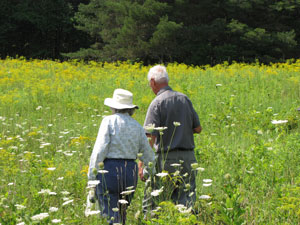 Rensselaer Land Trust holds a conservation easement on 15 private lands. Land under a conservation easement is owned by a private landowner. A conservation easement does not mean that the property is open to the public. Rensselaer Land Trust holds some of the property rights, including the right to restrict development of the land. Most landowners elect to retain control over access to the land. Of our 15 conservation easement lands, four allow for public access. Please click on the Conservation Easement lands links below to find out more about our conservation easement properties.
Rensselaer Land Trust holds a conservation easement on 15 private lands. Land under a conservation easement is owned by a private landowner. A conservation easement does not mean that the property is open to the public. Rensselaer Land Trust holds some of the property rights, including the right to restrict development of the land. Most landowners elect to retain control over access to the land. Of our 15 conservation easement lands, four allow for public access. Please click on the Conservation Easement lands links below to find out more about our conservation easement properties.
 With the assistance of area naturalists Steve Young and Russell Dunn, the Rensselaer Land Trust identified 56 waterfalls in Rensselaer County. To find out more about the waterfalls, including locations and descriptions, see Russell Dunn’s Adirondack Waterfall Guide: New York's Cool Cascades.The five waterfalls featured here were those which were visited on the 2000 RensselaerTaconic Land Conservancy (RTLC) waterfalls outing.
With the assistance of area naturalists Steve Young and Russell Dunn, the Rensselaer Land Trust identified 56 waterfalls in Rensselaer County. To find out more about the waterfalls, including locations and descriptions, see Russell Dunn’s Adirondack Waterfall Guide: New York's Cool Cascades.The five waterfalls featured here were those which were visited on the 2000 RensselaerTaconic Land Conservancy (RTLC) waterfalls outing.
Explore natural areas and the rich history of Rensselaer County through these publications, which were a labor of love by our directors over the past 25 years. Some of the areas described in the portfolios are open to the public. This provides a rich opportunity to read about the history of these areas in depth and then visit the sites for a look at local history today.


